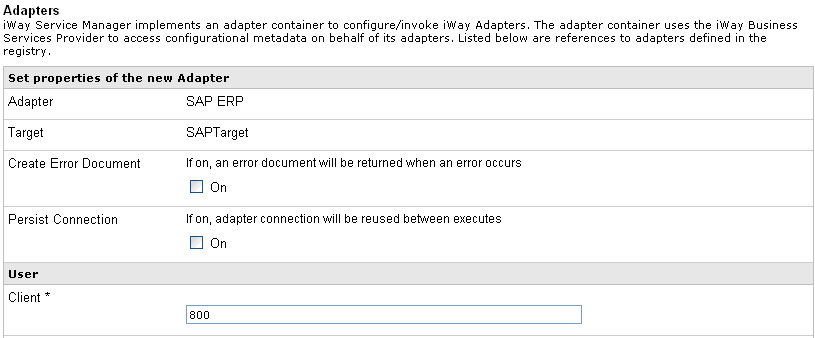Configuring the Adapter in iWay Service Manager
Before configuring the adapter in iWay Service Manager
(iSM), you must first create a target, which represents a connection
to a backend system, using iWay Explorer. For more information on
configuring targets and connections using iWay Explorer, see Configuring Adapter Targets and Creating XML Schemas or the iWay Explorer User's Guide.
You configure the adapter in the iSM Administration Console.
The configuration process creates run-time connection and persistent
data files within iSM. The configuration process interrogates the
iSM repository entries that were built when the target and connection
were created using iWay Explorer. The define adapter process creates
the run-time repository based on the design-time repository.
x
Procedure: How to Define the Adapter
To
define the adapter:
-
In the iSM Administration Console, select Registry,
then Adapters.
-
Click Add.
The iBSP URL pane opens, as shown in the following image.

-
Enter your iBSP URL, which is the location of the Service Manager repository,
for example, http://localhost:9000. This field is
required.
-
Click Next.
An adapter selection pane opens, as shown in the following
image.

-
From the Adapter drop-down list, select the Adapter, then click Next.
-
From the Target drop-down list, select a target you configured
for the adapter in iWay Explorer, then click Next.
The connection information associated with the target selected
is displayed.

-
Select whether to return an error document when an error occurs.
-
Select whether an adapter connection will be reused between executes.
-
Review the connection information you specified in iWay Explorer.
You can change or update any information.
-
Click Next.
-
Provide a name and, optionally, a description, for the adapter,
and click Finish.
The adapter appears in the adapters list, as shown in the
following image.

x
Procedure: How to Modify or Update an Adapter Connection
The
following image shows the Adapter Defines pane which displays the
name of the adapter and the description (optional).

To modify or update
an adapter connection:
-
From the Adapters list, click the adapter reference you defined,
in this example, SAP ERP.
The pane that displays the target connection information
opens. You cannot change the name of the adapter or the target,
but you can edit the connection information.
-
After you modify the connection information, click Update Connection
Properties.
-
After you make changes or additions to the adapter target in
iWay Explorer, click Update Adapter Data.
-
Click Finish.
After you have defined the SAP ERP adapter in iSM, you
can now use the adapter target in iSM channels or import the adapter
into the iWay Integration Tools (iIT) Designer for use in process
flows and applications.
x
Procedure: How to Define an SAP Listener in the iSM Administration Console
To define an SAP listener in the iSM Administration Console:
-
In the iSM Administration Console, select Registry,
as shown in the following image.

-
Click Listeners in the left pane
(under Components), as shown in the following image.

The Listeners pane
opens.
-
Click Add.
The Select listener type pane opens, as shown in the following
image.

-
Select SAP-ERP-AS (Application
Server) or SAP-ERP-MS (Message Server) from
the Type drop-down list and click Next.
A configuration page for the selected listener (SAP-ERP-AS
or SAP-ERP-MS) is displayed. You can refer to Configuring the System Tab for more information on the configuration
parameters that are required for the selected listener.
-
After you have provided values for all of the required
SAP listener configuration parameters, click Next.
-
Provide a name and a description for your SAP listener
and then click Finish.
The configured SAP listener is added to the Listeners pane.
The SAP listener can now be used in iSM channels or imported into
iWay Integration Tools (iIT) Designer for use in process flows and
applications.
For more information, see the iWay Service
Manager User’s Guide and iWay Service Manager Programmer’s Guide.






